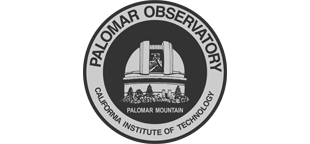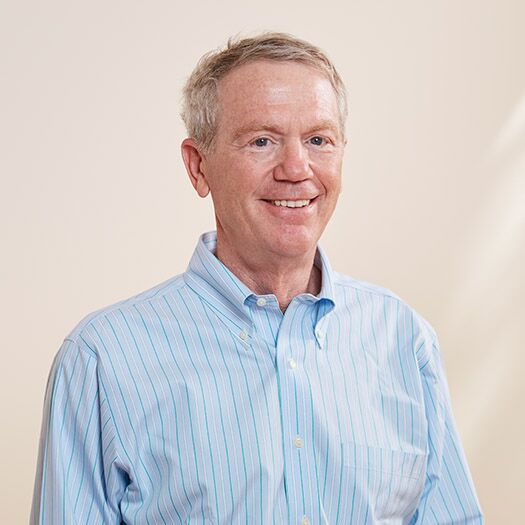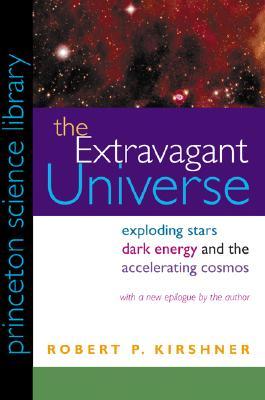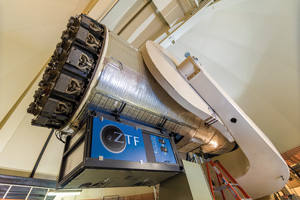
|
|

|
Commemoration
Palomar Science Meeting 2018 Public Event – Free Admission
2pm Tuesday July 10, Hameetman Auditorium (Cahill, Caltech)
PSM Tuesday 10 July public afternoon event will include keynote speakers (Ronald Florence—author of "The Perfect Machine", and Robert Kirshner of the Moore Foundation) and the Dedication of the Zwicky Transient Facility. The event begins at 2pm at the Hameetman Auditorium of the Cahill Center for Astronomy and Astrophysics and will be followed by a reception. The closest parking structure is located behind the building, though parking may be limited.
Ronald Florence – Creating “The Perfect Machine”


Author Ronald Florence and his book The Perfect Machine. (ronaldflorence.com)
Ronald Florence, Ph.D., is a novelist and historian, author of twelve books including Lawrence and Aaronsohn, The Gypsy Man, The Perfect Machine, Blood Libel and Emissary of the Doomed. He first visited Palomar as a high school student shortly after Sputnik was launched. Educated at Berkeley and Harvard, he taught at colleges and universities, ran a foundation, raced sailboats, and raised Cotswold sheep before turning to full-time writing. He lives in Providence, RI and travels in Europe and the Middle East to research his books.
His acclaimed book The Perfect Machine is the story of the thirty-year-long, ultimately successful struggle to build an incredible machine—a telescope large enough and perfect enough to see to the very edge of the universe. It is an inspiring account of the birth of big science and of America at its can-do apex. Countless scientists, engineers, administrators, and workmen—from Edwin Hubble, John D. Rockefeller, Elihu Root and Andrew Carnegie, to unemployed laborers who hiked up the mountain in search of a Depression job—come alive in this story of two decades of effort to create “the perfect machine.” The challenge of designing and building an instrument as huge as the Pantheon and as heavy as the Statue of Liberty, yet so precise that the 17-foot diameter mirror is polished to a tolerance of 2/1,000,000 of an inch, became an obsession. George Hale, famed as an astronomer and administrator of science, over-saw the early days of the project from a darkened room where he fled the demons that troubled his mind. Marcus Brown, a former chicken-farmer, drove the team polishing the mirror with demands for perfection that hovered on the brink of madness. For hundreds of others, a contribution to the telescope project was the centerpiece of a working career.
The Perfect Machine inspired the 2008 PBS documentary The Journey to Palomar by filmmakers Todd and Robin Mason. Twenty years ago, for Palomar Observatory's 50th anniversary, Florence wrote Palomar, After 50 Years for the San Diego History Center.
Robert Kirshner – Accelerating Discovery


Robert Kirshner and his book The Extravagant Universe. (UCSC/PSL)
Robert Kirshner, Ph.D., is the Chief Program Officer for science at the Gordon and Betty Moore Foundation. Kirshner leads the team responsible for distributing more than $100 million per year for the research and technology that enables fundamental scientific discoveries.
Kirshner graduated from Harvard College in 1970 and received a Ph.D. in Astronomy at Caltech. He was a postdoc at the Kitt Peak National Observatory, and was on the faculty at the University of Michigan for 9 years. In 1986, he moved to the Harvard Astronomy Department, where he serves as Harvard College Professor of Astronomy and Clowes Professor of Science at Harvard University. He was Chairman of the Department from 1990-1997 and the head of the Optical and Infrared Division of the CfA from 1997-2003.
Kirshner is an author of over 200 research papers dealing with supernovae and observational cosmology. His work with the High-Z Supernova Team on the acceleration of the Universe was dubbed the “Science Breakthrough of the Year for 1998” by Science Magazine. Kirshner and the High-Z Team shared in the Gruber Prize for Cosmology in 2007 and the 2014 Breakthrough Prize for Fundamental Physics. Additionally, Kirshner received the 2015 Wolf Prize for Physics winner for his role in uncovering the acceleration in the expansion of the universe. A member of the Amercian Academy of Arts and Sciences, he was elected to the National Academy of Sciences in 1998 and the American Philosophical Society in 2004. He served as President of the American Astronomical Society from 2003-2005. Kirshner was given the Distinguished Alumni Award by Caltech in 2004.
His popular book The Extravagant Universe: Exploding Stars, Dark Energy, and the Accelerating Cosmos was published by Princeton University Press. It won the AAP Award for Best Professional/Scholarly Book in Physics and Astronomy and was a Finalist for the 2003 Aventis Prize.
Shri Kulkarni – The Zwicky Transient Facility Dedication


Shri Kulkarni and the Samuel Oschin Telescop with the ZTF camera. (Caltech/COO)
Shrinivas (“Shri”) R. Kulkarni, Ph.D., is a George E. Hale Professor of Astronomy and Planetary Science at Caltech. He received an MS in Physics from the Indian Institute of Technology, Delhi In 1978 and a Ph. D. in Astronomy from University of California Berkeley (UCB) in December 1983. Following a post-doctoral fellowship at Berkeley and a Millikan Fellowship, he joined Caltech faculty in 1987. To date, he has mentored 29 graduate students and 40 postdoctoral fellows.
Kulkarni’s approach to research is to identify emerging areas of astronomy or use new methodologies that can be applied to existing areas of research. For his thesis, under the supervision of Carl E. Heiles, he developed an air-linked interferometer at the Arecibo Observatory and developed a new mode for the then newly commissioned Very Large Array and both were applied to study the diffuse neutral interstellar medium of our Galaxy. Towards the end of his thesis, working with Donald C. Backer, Kulkarni discovered the first millisecond pulsar at the Arecibo Observatory. As a Millikan Fellow he discovered optical counterparts to binary pulsars — a discovery which upturned the conventional wisdom that magnetic fields in neutron stars decay with time. He led or participated in the following discoveries: the first pulsar in a globular cluster, the first brown dwarf, suggesting a Galactic origin for soft gamma-ray repeaters and establishing the extra-galactic nature of gamma-ray bursts.
Over the past decade Kulkarni focused on systematic exploration of the night sky. The first phase was the Palomar Transient Factory (PTF) and was based on 8 square degree camera at the Samuel Oschin telescope. The second phase had, in addition, a robotic spectrograph on the Palomar 60-inch telescope. This effort culminated in the Zwicky Transient Facility which is centered around a 47 square degree camera on the Oschin telescope. ZTF is supported by a generous grant from the National Science Foundation and seven universities around the world as well as contributions from DOE laboratories. The notable discoveries from PTF and iPTF include identifying the emerging class of super-luminous supernovae, clarifying the origin of type Ia supernovae, detecting gamma-ray bursts without a gamma-ray trigger, showing a link between tidal disruption events (which are thought to be disruption of stars by massive black holes at the centers of galaxies) and “E+A” galaxies, demonstrating the methodology of “flash spectroscopy” to trace circumstellar matter around massive stars and assembling samples of Calcium-rich supernovae, rapidly spinning asteroids, etc.
To date, Kulkarni has over 500 refereed papers to his credit with 63 papers in Nature and six in Science. He has received many awards with the most notable being the NSF Waterman Award and the Dan David Prize. Kulkarni is a fellow of the Royal Society of London, the US National Academy of Sciences, the Indian Academy of Sciences and the Royal Netherlands Society of Arts & Sciences.
Questions? We've answered many common visiting, media, and academic questions in our public FAQ page.
Please share your feedback on this page at the
COO Feedback portal.
Commemoration / v 0.1
Last updated: 12 June 2018 ACM/AFB
|
|
|